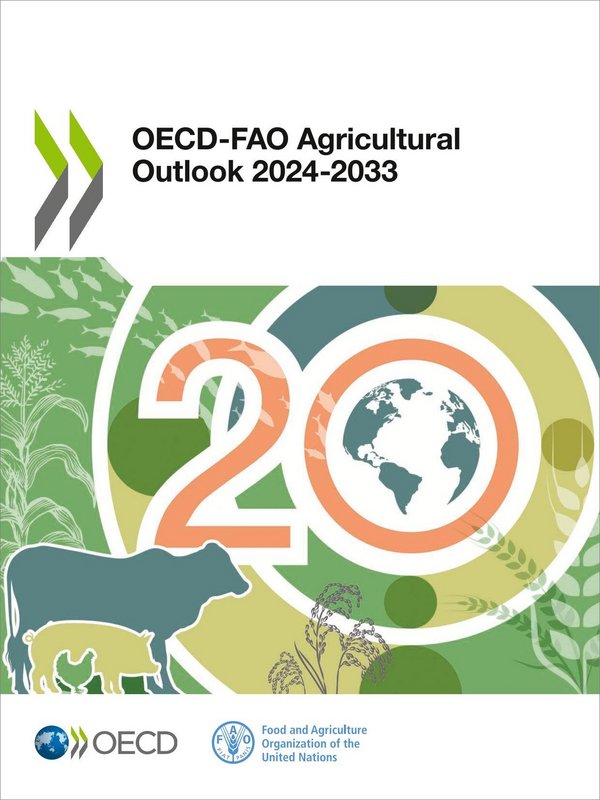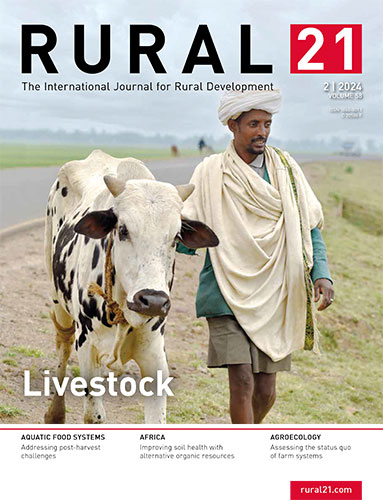 Read this article in French
Read this article in French- Share this article
- Subscribe to our newsletter
Agricultural Outlook 2024-2033
Emerging economies have increasingly driven global agricultural market developments over the last 20 years and are projected to continue to do so over the next decade, but with regional shifts linked to changing demographics and new economic affluence, according to the OECD-FAO Agricultural Outlook 2024-2033 published by the Food and Agriculture Organization of the United Nations (FAO) and the Organisation for Economic Co-operation and Development (OECD) in July 2024.
A notable shift expected over the coming decade is the increasing role of India, Southeast Asia and Sub-Saharan Africa and the declining role played by China. While China accounted for 28 per cent of growth in global consumption of agriculture and fisheries in the previous decade, its share of additional demand over the coming decade is projected to fall to 11 per cent, attributed not only to a declining population and slower income growth but also to a stabilisation of nutrition patterns.
India and Southeast Asian countries are projected to account for 31 per cent of global consumption growth by 2033, driven by their growing urban population and increasing affluence. Among predominantly low-income regions, Sub-Saharan Africa is projected to contribute a sizeable share of additional global consumption (18 per cent), primarily due to population growth-driven demand for food.
Agricultural and fisheries demand expected to rise
Total agricultural and fisheries consumption (as food, feed, fuel and other industrial raw materials) is projected to grow by 1.1 per cent annually over the next decade, with nearly all of the additional consumption projected to occur in low- and middle-income countries. Food calorie intake is expected to increase by 7 per cent in middle-income countries, largely due to greater consumption of staples, livestock products and fats. Calorie intake in low-income countries will grow by 4 per cent, too slowly to achieve the Sustainable Development Goal target of zero hunger by 2030.
Growth in crop production is projected to be driven primarily by productivity increases on existing land rather than an expansion of the cultivated area, leading to a decline in agriculture’s global greenhouse gas (GHG) emissions intensity. Similarly, a significant proportion of the growth in livestock and fish production is expected to result from productivity improvements, although herd expansions will also contribute to production growth. Direct emissions from agriculture are therefore projected to increase by 5 per cent over the projection period.
Scenario of halving food losses
This year's Outlook features a scenario that simulates the impact of halving food losses along supply chains and food waste at the retail and consumer levels by 2030. The scenario projects a potential 4 per cent reduction in global agricultural GHG emissions by 2030, distributed relatively evenly across countries regardless of income levels. It also projects food prices to fall, resulting in increased food intake in low- and lower middle-income countries by 10 per cent and 6 per cent respectively, potentially reducing the number of undernourished people by 153 million (-26 per cent) by 2030. While the scenario highlights potential benefits for consumers and the environment, it also points to challenges for producers, as lower producer prices and decreased production would notably impact their livelihoods.
As with previous editions, the Outlook offers decadal projections for cereals, oilseeds, vegetable oils, sugar, meat, fish, dairy products, as well as cotton, roots and tubers, pulses, bananas and tropical fruits and biofuels. The market projections are the bases for indicators on nutrition and greenhouse gas emissions from agriculture.
(FAO/ile)
More information:





Add a comment
Be the First to Comment